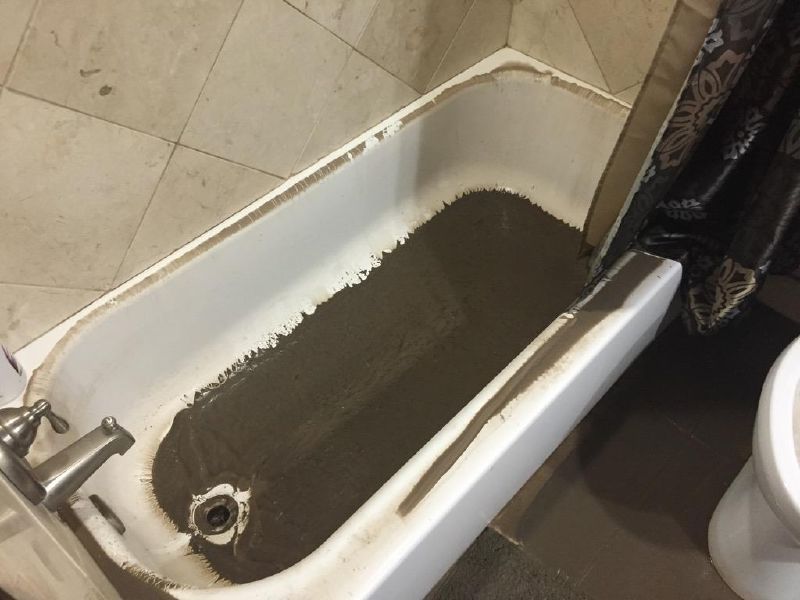What are your ideas about What to Do if Sewage Starts Coming Up Through Your Bathtub?

Sewer back-up in the tub can be a stressful and unhygienic trouble for any type of homeowner. Not just is it bothersome, however it likewise positions major health risks and indicates underlying problems with the plumbing system. Recognizing why sewer is coming up via the bath tub is important for taking suitable activity to address the problem properly.
Introduction to the Issue
Comprehending the Issue
When sewer draws back up into the bath tub, it's a clear sign of a trouble with the water drainage system. The wastewater that ought to be streaming far from your home is instead locating its way back into your space, which can lead to significant damages and health hazards.
Possible Causes
Numerous aspects can add to sewage backup in the bath tub. From clogs in the drain line to problems with the plumbing facilities, identifying the origin is essential for finding a remedy.
Typical Reasons for Sewer Back-up
Blockages in the Drain Line
Among one of the most usual sources of sewage back-up is an obstruction in the sewage system line. This can take place because of the buildup of debris, grease, or foreign objects in the pipes, protecting against proper flow and creating sewer to back up into your bath tub.
Tree Origin Invasion
Tree roots looking for moisture and nutrients can penetrate drain lines through small fractures or joints. In time, these origins can expand and expand, creating considerable damage to the pipes and causing sewer back-up problems.
Aging Infrastructure
Older homes might have dated plumbing systems that are much more susceptible to deterioration, fractures, and wear and tear. As pipes age, they become much more vulnerable to leaks and clogs, boosting the chance of sewage back-up incidents.
Heavy Rainfall or Flooding
During periods of heavy rainfall or flooding, the sewer system might end up being overwhelmed with excess water, causing backups and overflows. This can lead to sewage backing up right into bathtubs and various other fixtures inside the home.
Health And Wellness Dangers Related To Sewage Back-up
Contamination of Water Supply
Sewage back-up can pollute the water in your home, positioning a significant wellness risk to you and your household. Exposure to infected water can lead to stomach problems, skin infections, and various other health problems.
Spread of Disease
Sewage consists of unsafe bacteria, viruses, and parasites that can trigger a variety of illness, consisting of hepatitis, cholera, and gastroenteritis. Coming into contact with sewage or infected surfaces puts you at risk of infection.
Mold Development
Moisture from sewage backup can develop excellent problems for mold and mildew growth in your house. Mold and mildew spores can exacerbate respiratory problems and create allergic reactions in sensitive people, making prompt cleaning important.
Indications of Sewage Back-up
Foul Odors
Unpleasant smells rising from drains or fixtures, specifically in the washroom, may suggest sewer backup concerns. These smells are often solid and consistent, indicating an issue that calls for prompt interest.
Slow Draining Fixtures
Bathtubs, sinks, and bathrooms that drain pipes slowly or not at all could be experiencing sewage backup. If multiple fixtures are influenced simultaneously, it's likely that the issue originates from an usual point, such as the primary drain line.
Gurgling Sounds
Odd gurgling or bubbling sounds originating from drains pipes when water is running somewhere else in the house are a measure of air entraped in the plumbing system. This air accumulation can arise from sewer back-up and need to be checked out quickly.
Immediate Actions to Take
Turning Off Water Supply
In the event of sewage back-up, it's essential to shut off the water supply to avoid more contamination and damage. Situate the main water shutoff valve in your house and closed it off up until the concern can be settled.
Speaking To a Specialist Plumber
Handling sewage backup is not a DIY task. Contact a certified plumber with experience in taking care of sewage-related issues to analyze the scenario and do required repair work or cleanups.
Avoiding Contact with Contaminated Water
Till the sewer back-up is settled, avoid contact with contaminated water to prevent the spread of germs and virus. Use safety gear if you have to remain in the damaged location and wash your hands extensively later.
Preventive Measures
Routine Upkeep of Drain Lines
Arrange regular assessments and maintenance of your sewer lines to recognize and address possible issues prior to they intensify right into major troubles. This can consist of cleaning debris, examining for tree root breach, and repairing any kind of broken pipelines.
Setting Up Bayou Shutoffs
Think about mounting bayou shutoffs in your plumbing system to stop sewer from receding right into your home throughout periods of heavy rainfall or flooding. These valves instantly close when water starts backing up, securing your property from contamination.
Appropriate Disposal of House Waste
Stay clear of flushing anything besides toilet paper and human waste down the bathroom to avoid blockages and clogs in the sewage system line. Dispose of oil, oil, and other house chemicals correctly to decrease the danger of plumbing issues.
Cleaning Up After Sewage Backup
Sanitation Procedures
Completely decontaminate and disinfect influenced areas after sewage back-up to eliminate dangerous bacteria and protect against mold growth. Usage suitable cleansing products and protective gear to make sure safe and effective cleaning.
Repair of Impacted Locations
Fix any type of damage to flooring, wall surfaces, or fixtures triggered by sewage backup. Depending upon the degree of the damages, you might need to change carpets, drywall, or other products to restore your home to its pre-loss problem.
Why Is Water Backing Up in My Bathtub When I Flush My Toilet?
What to do about a sewer line clog
First, don’t bother with plunging. No amount of plunging will dislodge the clog in a sewer line. The clog is too far away. Plungers are for clogs in the toilet itself, not the sewer line. Plus, the most likely causes of a sewer clog are:
Tree roots Flushed toys or feminine products Grease buildup Those items don’t move easily. And in the case of tree roots, the roots need to be cut out of the pipe and the pipe will need to be repaired.
You’ll need a closet auger. A closet auger is a type of plumber’s snake with a protective cover to keep from scratching the delicate porcelain toilet. If the clog is further down, you may need to remove the toilet or use one of your cleanouts to get to the clog.
We also recommend doing a video inspection of the drain to ensure that the cause of the clog has been completely removed. Otherwise, you could have the same problem again in a few days or weeks.
https://mspplumbingheatingair.com/blog/why-is-water-backing-up-in-my-bathtub-when-i-flush-my-toilet

I recently found that piece about Why sewage is coming up through your bathtub while doing a search on the search engines. Are you aware of another person who is enthusiastic about What To Do If Sewage Starts Backing Up Into the Shower? Why not promote it. Thanks a lot for your time spent reading it.
Click